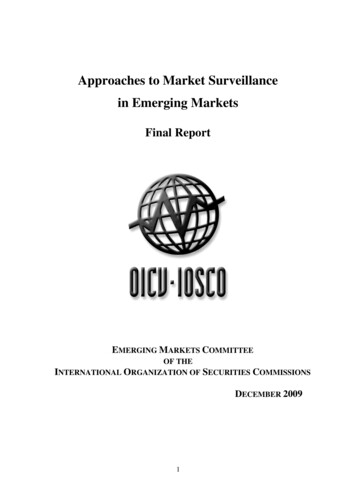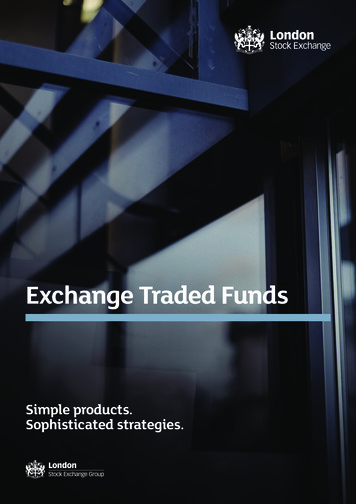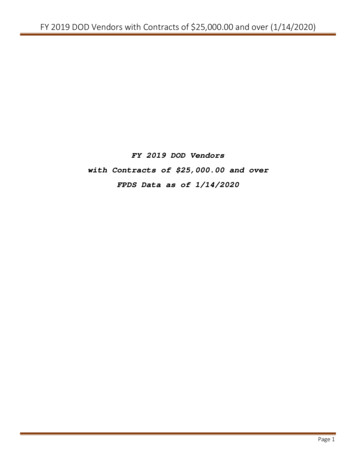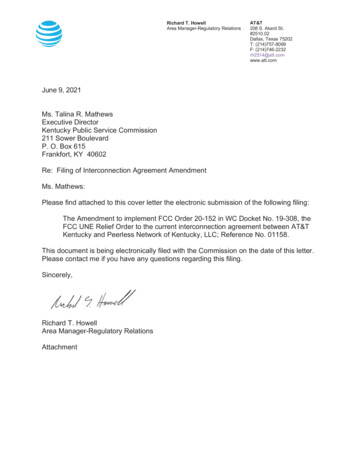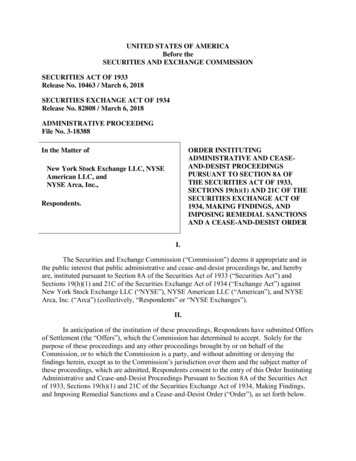
Transcription
UNITED STATES OF AMERICABefore theSECURITIES AND EXCHANGE COMMISSIONSECURITIES ACT OF 1933Release No. 10463 / March 6, 2018SECURITIES EXCHANGE ACT OF 1934Release No. 82808 / March 6, 2018ADMINISTRATIVE PROCEEDINGFile No. 3-18388In the Matter ofORDER INSTITUTINGADMINISTRATIVE AND CEASEAND-DESIST PROCEEDINGSPURSUANT TO SECTION 8A OFTHE SECURITIES ACT OF 1933,SECTIONS 19(h)(1) AND 21C OF THESECURITIES EXCHANGE ACT OF1934, MAKING FINDINGS, ANDIMPOSING REMEDIAL SANCTIONSAND A CEASE-AND-DESIST ORDERNew York Stock Exchange LLC, NYSEAmerican LLC, andNYSE Arca, Inc.,Respondents.I.The Securities and Exchange Commission (“Commission”) deems it appropriate and inthe public interest that public administrative and cease-and-desist proceedings be, and herebyare, instituted pursuant to Section 8A of the Securities Act of 1933 (“Securities Act”) andSections 19(h)(1) and 21C of the Securities Exchange Act of 1934 (“Exchange Act”) againstNew York Stock Exchange LLC (“NYSE”), NYSE American LLC (“American”), and NYSEArca, Inc. (“Arca”) (collectively, “Respondents” or “NYSE Exchanges”).II.In anticipation of the institution of these proceedings, Respondents have submitted Offersof Settlement (the “Offers”), which the Commission has determined to accept. Solely for thepurpose of these proceedings and any other proceedings brought by or on behalf of theCommission, or to which the Commission is a party, and without admitting or denying thefindings herein, except as to the Commission’s jurisdiction over them and the subject matter ofthese proceedings, which are admitted, Respondents consent to the entry of this Order InstitutingAdministrative and Cease-and-Desist Proceedings Pursuant to Section 8A of the Securities Actof 1933, Sections 19(h)(1) and 21C of the Securities Exchange Act of 1934, Making Findings,and Imposing Remedial Sanctions and a Cease-and-Desist Order (“Order”), as set forth below.
III.On the basis of this Order and Respondents’ Offers, the Commission finds that:IV.SummaryThis matter involves several episodes in which the NYSE Exchanges engaged in certainbusiness practices without having in place required and effective rules; operated in a manner thatdid not comply with the exchange rules then in effect; and/or operated in a manner that did notcomply with the federal securities laws. The NYSE Exchanges engaged in this conduct in thefollowing instances, which included several disruptive market events: NYSE and American’s July 8, 2015 Trading Halt: On July 8, 2015, two of the NYSEExchanges suspended intra-day trading for approximately three and one-half hours(the “Shutdown”). During the 47 minutes before the Shutdown, NYSE and Americanexperienced escalating connectivity problems between their trading units and thecommunications “gateways” used by customers, which eventually prevented manycustomers from being able to consistently access quotations in a majority of thesymbols traded on these exchanges (“Impaired Symbols”). As a result, quotations inthe Impaired Symbols were no longer automated. Nonetheless, during this timeperiod, NYSE and American continued to disseminate quotations for the ImpairedSymbols marked as “automated.” The quotations that were inaccurately identified asautomated after these exchanges had reason to believe otherwise constituted negligentmisrepresentations of material facts to market participants in violation of Section17(a)(2) of the Securities Act. Arca’s Use of Price Collars During the August 24, 2015 ETF Market Volatility: U.S.equity and equity-related futures markets experienced unusual volatility on August24, 2015. The volatility led to a total of 1,278 Limit-Up/Limit-Down (“LULD”)trading pauses on five exchanges. Arca, which was the primary listing exchange formore than 85% of these exchange traded products (“ETPs”), including exchangetraded funds (“ETFs”), had 999 (or 78%) of the LULD pauses, of which 697 wererepeat pauses in securities that were reopened after their first pause of the day. Manyof these repeat halts were caused, at least in part, because Arca applied price collarsto reopening auctions that followed LULD pauses. By applying these price collars,Arca’s order imbalances on reopening auctions resolved more slowly than they wouldhave with wider or no reopening collars and potentially limited the extent to whichthe prices of reopened issues could adjust to changing conditions without triggeringadditional LULD halts. Arca violated Section 19(b)(1) of the Exchange Act becauseits rules described price collars for opening and closing auctions, but not forreopening auctions. Arca also violated Section 19(g)(1) because it did not complywith its rules regarding reopening auctions. Arca’s Erroneous March 31, 2015 Trading Halt: On the morning of March 31, 2015,Arca erroneously implemented a market-wide regulatory halt that stopped all trading2
of 134 Arca-listed securities on all exchanges. Arca lifted the market-wide halt afterapproximately 20 minutes and resumed its own trading approximately two hourslater, but could not publish closing auction order imbalance information. As a result,Arca violated Rule 608(c) of Regulation NMS by imposing a market-wide halt inviolation of a national market system plan, and Section 19(g)(1) of the Exchange Actby violating its own rule that required Arca to publish closing order imbalanceinformation. NYSE and American’s Failure to Comply with Reg SCI’s Business Continuity andDisaster Recovery Requirements: Regulation Systems Compliance and Integrity(“Reg SCI”) requires national securities exchanges and other SCI entities to havebusiness continuity and disaster recovery (“BC/DR”) plans that provide for certain“reasonably designed” backup and recovery capabilities. For approximately one yearfollowing Reg SCI’s November 3, 2015 effective date, NYSE and American, in awide-scale disruption, would have relied on the backup systems of Arca for trading inNYSE- and American- listed symbols. NYSE and American accordingly lacked therequired policies and procedures for “reasonably designed” backup and recoverycapabilities and therefore violated Reg SCI Rules 1001(a)(1) and 1001(a)(2)(v). NYSE and American’s Failure to State Material Aspect of Operation of ExchangeOrder Types: From 2008 to 2015, the interaction between two order-types on NYSEand American—pegging orders and non-displayed reserve orders—created thepossibility that floor brokers’ pegging orders could in certain circumstances detect thepresence (but not the quantity) of non-displayed depth liquidity on the exchanges’order books. This potential behavior was a material aspect of the operation of theexchanges, but it was not described in any effective rules of NYSE or Americanduring this period, despite a customer complaint that brought the potential behavior tothe exchanges’ attention. As a result, NYSE and American violated Section 19(b)(1)of the Exchange Act.Respondents1.New York Stock Exchange LLC is a national securities exchange registeredwith the Commission pursuant to Section 6 of the Exchange Act. NYSE is a New York limitedliability company and an indirect, wholly-owned subsidiary of Intercontinental Exchange, Inc.(“ICE”). The Commission previously has brought enforcement actions against NYSE. Mostrecently, in 2014, the Commission found that NYSE, American, and Arca violated Sections19(b)(1) and 19(g)(1) of the Exchange Act for failing to have effective rules relating to colocation services, operation of a block trading facility and error account, and distribution ofclosing order imbalance information, among other things, and ordered them to cease and desistfrom committing or causing any violations and any future violations of Sections 19(b)(1) and19(g)(1). In the Matter of New York Stock Exchange LLC, NYSE Arca, Inc., NYSE MKT LLCf/k/a/ NYSE Amex LLC, and Archipelago Securities, LLC, Exchange Act Release No. 72065(May 1, 2014) (“2014 Order”).2.NYSE American LLC (f/k/a NYSE MKT LLC) is a national securitiesexchange registered with the Commission pursuant to Section 6 of the Exchange Act. American3
currently is a Delaware limited liability company and an indirect, wholly-owned subsidiary ofICE. As noted supra, the Commission also brought a case against NYSE MKT LLC in 2014.3.NYSE Arca, Inc. is a national securities exchange registered with theCommission pursuant to Section 6 of the Exchange Act. Arca is a Delaware corporation and anindirect, wholly-owned subsidiary of ICE. As noted supra, the Commission also brought a caseagainst Arca in 2014.FactsA.On July 8, 2015, NYSE and American Negligently Represented That TheirQuotations Were Automated When They Were NotRegulation NMS’s Legal Framework for Automated Trading Centers4.Rules 600(b)(4)(ii) and (iii) of Regulation NMS define an “automated tradingcenter” as a trading center that “[i]dentifies all quotations other than automated quotations asmanual quotations” and “[i]mmediately identifies its quotations as manual quotations wheneverit has reason to believe that it is not capable of displaying automated quotations.” To beconsidered an automated trading center, Rule 600(b)(4)(iv) of Regulation NMS also requires thatthe trading center “adopt[] reasonable standards limiting when its quotations change fromautomated quotations to manual quotations, and vice versa, to specifically defined circumstancesthat promote fair and efficient access to its automated quotations and are consistent with themaintenance of fair and orderly markets.” NYSE and American receive payments fortransmitting certain automated quotations to the Securities Information Processors (“SIP”).15.Rule 600(b)(57) of Regulation NMS defines “protected bid or protected offer” as“a quotation in an NMS stock” that is: (i) “displayed by an automated trading center”; (ii)“disseminated pursuant to an effective national market system plan”; and (iii) is an “automatedquotation that is the best bid or best offer” of a national securities exchange or another relevantmarket participant. Rule 600(b)(58) of Regulation NMS defines “protected quotation” as a“protected bid or a protected offer.”6.Rule 611 under Regulation NMS (the “Order Protection Rule”) generallyobligates trading centers to honor the “protected quotations” of other trading centers by notexecuting trades at inferior prices, or “trading through” such protected quotations. Only an“automated trading center” displaying “automated quotations” is entitled to this protection.7.Following input specifications provided by the network processor for theconsolidated quote system, NYSE and American used the condition code “R” (Regular) toindicate that a quotation was automated. On July 8, 2015, however, NYSE and American did nothave reasonable standards specifying the circumstances in which these exchanges could nolonger identify quotations in particular symbols as automated.1An exchange’s share of market data revenue collected by a SIP is calculated annually according to a formula thatincludes, among other factors, the exchange’s share of automated, but not manual, quotations transmitted to the SIPthat equal the price of the national best bid or offer for at least one full second. For NYSE and American, this prorata revenue share for the relevant time period on July 8, 2015 (10:45 a.m. to 11:32 a.m.) was approximately 9,000.4
NYSE and American Negligently Marked Quotations as Automated When They Had“Reason to Believe” They Were Not Capable of Displaying Automated Quotations8.Beginning at approximately 10:45 a.m. on July 8, 2015, NYSE and Americanexperienced escalating connectivity problems between their trading units and customergateways. The exchanges received numerous internal and external notifications that showed thatthe connectivity problems were continuing.9.From 10:45 a.m., the exchanges’ internal monitoring systems began issuing alertsthat showed connectivity problems between certain trading units and customer gateways.Multiple staff at the exchanges received these alerts. Over the next 47 minutes –– until the 11:32a.m. Shutdown –– the exchanges’ internal monitoring systems issued an increasing number ofalerts illustrating that the connectivity problems had spread to numerous trading units andcustomer gateways.10.As reflected in the internal alerts, by 11:14 a.m., 22 out of the exchanges’ 25primary trading units had been experiencing connectivity problems to various customergateways. That meant that if a customer was attempting to connect through a gateway that hadlost connectivity to a trading unit, the customer could not access quotations in symbols handledon the affected trading unit. As a result, by 11:14 a.m., customers’ ability to access quotationshad been affected for the majority of the symbols traded on the exchanges.11.NYSE and American also received multiple external notifications that further putthe exchanges on notice of the escalating issues. First, starting at 10:51 a.m., several othertrading centers and market participants began declaring “self-help” against NYSE and Americanand/or halted order routing to these exchanges. Additionally, beginning at approximately 10:45a.m. and until the Shutdown, several of the exchanges’ members also contacted the exchangesabout their individual connectivity problems.12.By 11:07 a.m., senior staff in the exchanges’ systems operations group believedthat the exchanges were experiencing persistent gateway and trading unit connectivity issues. Atapproximately 11:17 a.m., the exchanges launched an internal conference call pursuant to theirincident response procedures in which senior management discussed the ongoing connectivityproblems and a possible suspension of trading. At approximately 11:27 a.m., the President of theexchanges ordered a full trading suspension, which took effect at approximately 11:32 a.m.13.For a significant portion of the time period before the Shutdown, NYSE andAmerican therefore had “reason to believe” that they were “not capable of displaying automatedquotations” consistent with Regulation NMS Rule 600(b)(4)(iii) for the Impaired Symbols.During this timeframe, the exchanges did not meet the definition of an “automated tradingcenter” under Rule 600(b)(4) of Regulation NMS because they did not have reasonable standardsspecifying the circumstances in which the exchanges could no longer identify quotations asautomated and did not immediately identify quotations as manual quotations when they hadreason to believe that they were not capable of displaying automated quotations.14.During that timeframe, NYSE and American continued to transmit quotations forthe Impaired Symbols with quote condition “R,” indicating they were still automated even5
though the connectivity problems rendered them inaccessible. At no point did the exchangesidentify those quotations as manual or suspend trading in the Impaired Symbols. Thus, theexchanges negligently represented to market participants, including broker-dealers routing orderson behalf of their customers, that their quotations for the Impaired Symbols were automatedquotations entitled to trade-through protection under Rule 611, which was not true. As a result,the condition codes transmitted by the exchanges for quotations in the Impaired Symbolsconstituted negligent misrepresentations or omissions of material fact to such marketparticipants.15.By marking the quotations for the Impaired Symbols with quote condition R,NYSE and American also indicated that the quotations qualified as “protected quotations” underRule 611, even though they did not meet the definitions set forth in Rule 600(b)(57) and shouldnot have received the trade-through protections of Rule 611.16.After the events of July 8, 2015, NYSE and American adopted standards underRule 600(b)(4)(iv) for determining if customer connectivity is insufficient to maintain automatedquotations and, if such a determination is made, to suspend trading.B.Arca Improperly Applied Price Collars to Reopening Auctions DuringAugust 24, 2015 Market Volatility17.On August 24, 2015, following an overnight decline of more than 8% in theShanghai Composite stock index, U.S. equity and equity-related futures markets experiencedunusual price volatility. Prices of equities and ETPs were particularly volatile during the periodsurrounding the 9:30 a.m. ET start of regular trading. The extreme volatility led to a total of1,278 LULD trading pauses on five exchanges (BATS, NASDAQ, NYSE, Arca, andAmerican).2 Arca, which was the primary listing exchange for more than 85% of these ETPs,had 999 (or 78%) of the LULD pauses, of which 697 were repeat pauses in securities that alreadyhad experienced one pause that day. The volatility and pauses generated widespread marketattention.318.On August 24, 2015, Arca applied price collars to reopening auctions conductedto resume trading after LULD pauses, using the following thresholds: 1% for stocks with pricesover 50.00, 2% for stocks with prices from 25.01 to 50.00, and 5% for stocks with prices 25.00 and under (referred to as “1-2-5%” collars).4 Calculation of the collars was based on thelast trade prior to the auction.2Limit-up/limit-down trading pauses are required by a national market system plan to address market volatility thatthe Commission approved in 2011. The plan has been amended several times since then.3For more information about this trading event, see generally, Equity Market Volatility on August 24, 2015,Research Note by the Staff of the Office of Analytics and Research, Division of Trading and Markets, December2015, available at y market volatility.pdf; and Austin Gerig andKeegan Murphy, Division of Economic and Risk Analysis, The Determinants of ETF Trading Pauses on August24th, 2015, February 2016, available at rminants-etf-tradingpauses.pdf.4Arca calculated the trading collar price based on the specified percentage away from the consolidated last saleprice.6
19.Because of the 1-2-5% collars that were applied during the reopening auctions,the volume of shares available for execution in the reopening auctions was less than would havebeen available if wider collars, or no collars, had been in effect. On August 24, 2015, becausethe 1-2-5% price collars limited the extent to which trading could reopen at prices reflectingchanging supply and demand, some market orders and limit orders could not be executed untilmultiple reopening auctions occurred. While Arca did not delay reopenings based on unmatchedmarket orders, these orders were not cancelled, and they remained on the order book whencontinuous trading resumed after the auction, often creating an imbalance of supply and demandthat triggered additional LULD pauses, both on the lower end as prices fell and on the upper endas prices rebounded. The 1-2-5% collars therefore led to more repeat LULD pauses than wouldhave occurred if wider collars (or no collars) had been in effect. Of the 302 securities listed onArca that experienced at least one LULD pause that day, 201 (or 67%) experienced multiplepauses.20.Arca’s application of price collars to reopening auctions was a material operationof the exchange that should have been the subject of an effective exchange rule. On August 24,2015, however, Arca described opening and closing auction collars in its rules, but did notinclude reopening auction collars in its rules. Arca’s failure to have an effective exchange ruleregarding the application of price collars to reopening auctions violated Section 19(b)(1) of theExchange Act.21.Arca’s application of price collars to LULD reopening auctions also violatedSection 19(g)(1) of the Exchange Act because Arca’s rules in place on August 24, 2015regarding reopening auctions stated that the reopening price would be determined by theindicative match price in the auction and did not provide for the application of any collars to thereopening price. By applying 1-2-5% collars, Arca failed to follow its own rules for determiningthe price in reopening auctions in violation of Section 19(g)(1) of the Exchange Act.22.Arca remediated the gap in its rules following the market events of August 24,2015. Arca promptly engaged in discussions with Commission staff concerning a proposed ruleamendment to reflect the exchange’s use of collars in reopening auctions, and filed a ruleproposal on December 7, 2015. The Commission approved it on January 28, 2016.C.On March 31, 2015, Arca Erroneously Implemented a Regulatory Halt andFailed to Publish Closing Order Imbalance InformationErroneous Regulatory Halt23.At approximately 10:05 a.m. on March 31, 2015, the trade process on one ofArca’s trading units entered a software loop while processing an order. While in the loop state,the trade process sent 212 million extraneous messages to Arca’s market data publishingapplication, which accumulated the messages in a queue.24.Over the next approximately 20 minutes, Arca unsuccessfully attempted to clearthe queue. Thereafter, Arca decided to suspend trading at Arca in the 134 affected symbols, forwhich it was the primary listing exchange, while it addressed the issue by clearing all live orders.At that time, Arca issued the following informational message to the market: “NYSE Arca is7
currently unavailable in Tape B symbol range UTG - ZSML. All live orders, with the exceptionof GTC orders, will be canceled in impacted symbols.”25.Although Arca intended to suspend trading only on Arca, which would allowtrading of Arca-listed securities to continue on other exchanges, Arca inadvertently implementeda “regulatory halt” that stopped trading in the 134 Arca-listed securities on all exchanges. Arcapersonnel mistakenly implemented this regulatory halt because the system operations teamincorrectly consulted and ran commands for a “halt procedure” in Arca’s runbook that triggeredthe distribution of a message to all market centers that a regulatory halt was in effect for all 134securities.26.Section XI(a) of the Consolidated Tape Association (“CTA”) Plan, which is thenational market system plan for disseminating consolidated information about transactions instocks listed on exchanges other than NASDAQ, provides for regulatory halts in two scenarios:(1) when there are “matters relating to such security or the issuer thereof, which have not beenadequately disclosed to the public,” (i.e., news dissemination), or (2) when “there are regulatoryproblems relating to such security which should be clarified before trading therein is permitted tocontinue” (e.g., an SEC-ordered trading suspension). The CTA Plan does not authorize theimposition of a market-wide regulatory halt in response to technical problems such as those Arcaexperienced on March 31, 2015. Arca’s imposition of a regulatory halt, even though mistaken,therefore violated the CTA Plan. This violation was, in turn, a violation of Rule 608(c) ofRegulation NMS, which requires a national securities exchange, as a self-regulatoryorganization, to comply with national market system plans of which it is a sponsor or participant.Failure to Publish Closing Order Imbalance Information27.At 10:46 a.m., approximately 20 minutes after imposing the mistaken marketwide regulatory halt, Arca lifted that halt and implemented the correct Arca-specific tradingsuspension. Later, at approximately 12:19 p.m., Arca lifted the trading suspension and resumedtrading in the affected securities. At that time, Arca issued the following informational message:“All systems are functioning normally in Tape B symbols UTG - ZSML as of 12:19 p.m. ET.Customers are advised to use the SIP feed for market data and not rely on the Arcabook feed forthe remainder of the day for Tape B symbol range UTG - ZSML.” Arca issued this notificationbecause Arca’s proprietary feed Arcabook had been impaired by the restart of Arca’s market datapublisher to resolve the underlying technical issue.28.Former Arca Rule 7.35(e),5 which was in effect at the time, required Arca topublish the following information for traders “via electronic means” in advance of the dailyclosing auction for each Arca-listed security: (i) the best price at which the maximum volume ofshares would be traded in the auction based on orders received as of that time (the “IndicativeMatch Price”); (ii) the number of shares that would trade at that price (“volume available to tradeat such price”); and (iii) the imbalance between buy and sell orders that would not execute if theauction were conducted at that price (the “Total Imbalance and Market Imbalance”). Arca’srules required publication of this data beginning at 3:00 p.m. ET and would then update the datain real time thereafter.5The rule has since been amended and renumbered as Arca Rule 7.35(d).8
29.Because the Arcabook proprietary feed was unavailable, Arca was unable todistribute order imbalance information or indicative match pricing information via that feed inadvance of the closing auctions in compliance with former Arca Rule 7.35(e).30.Arca’s decision to run the closing auctions without first disseminating therequired information via Arca’s proprietary feed had negative consequences. The price of atleast eight heavily traded ETFs varied significantly from the values of their underlying securities.The impact of these closing prices was heightened by the outage having occurred on the last dayof a quarter, a day that investment companies report the quarter end values of their holdingsbased on closing price.31.By not disseminating the required information via Arca’s proprietary feed, Arcaviolated former Arca Rule 7.35(e) and, in turn, Section 19(g)(1) of the Exchange Act, whichrequires exchanges to comply with their own rules.32.Arca took remedial action after the events of March 31, 2015. It revised itsoperating procedures to clearly distinguish the processes to be used to implement regulatory andnon-regulatory halts, and participated in an industry initiative to allow exchanges to serve asdesignated backups for one another when a primary listing exchange is unable to hold a closingauction, and to establish a time during the trading day by which Arca (and other NYSEExchanges) determine whether to hold a closing auction or rely on its backup exchange.D.NYSE and American Failed to Comply with Reg SCI’s Business Continuityand Disaster Recovery RequirementsNYSE and American’s Obligations to Comply with Reg SCI’s BC/DR Requirements33.The Commission proposed Reg SCI in March 2013, and adopted it in December2014, to require in relevant part that key market participants have policies and procedures to helpensure the robustness and resiliency of their technology systems.6 Rule 1001(a)(1) of Reg SCIprovides that “[e]ach SCI entity shall establish, maintain, and enforce written policies andprocedures reasonably designed to ensure that its SCI systems and, for purposes of securitystandards, indirect SCI systems, have levels of capacity, integrity, resiliency, availability, andsecurity, adequate to maintain the SCI entity’s operational capability and promote themaintenance of fair and orderly markets.”734.Rule 1001(a)(2)(v) of Reg SCI in turn states that the policies and proceduresrequired by Rule 1001(a)(1) for each SCI entity must encompass “at a minimum” sevenenumerated topics, one of which is “[b]usiness continuity and disaster recovery plans thatinclude maintaining backup and recovery capabilities sufficiently resilient and geographicallydiverse and that are reasonably designed to achieve next business day resumption of trading and6See Regulation Systems Compliance and Integrity, Final Rule Release, 79 Fed. Reg. 72252, 72253 (Dec. 5, 2014).Reg SCI Rule 1000 defines “SCI entity” as an SCI self-regulatory organization, SCI alternative trading system,plan processor, or exempt clearing agency subject to the Commission’s Automation Review Policies and defines“SCI systems” as “all computer, network, electronic, technical, automated, or similar systems of, or operated by oron behalf of, an SCI entity that, with respect to securities, directly support trading, clearance, and settlement, orderrouting, market data, market regulation, or market surveillance.”79
two-hour resumption of critical SCI systems following a wide-scale disruption.” 8 Rule1001(a)(2)(v).35.Because NYSE and American each meet the definition of an SCI entity, each ofthese exchanges must comply with Rules 1001(a)(1) and 1001(a)(2)(v). The effective date forReg SCI was February 3, 2015, and the compliance date for the relevant provisions relating toBC/DR plans was November 3, 2015.NYSE and American’s Failure to Comply with Reg SCI’s Business Continuity andDisaster Recovery Requirements36.NYSE, American, and Arca maintain separate primary trading systems. Each ofthese systems is located in a Mahwah, New Jersey data center (“Mahwah”). The NYSEExchanges’ backup systems are located at a data center in Chicago, Illinois (“Chicago”).37.Under the BC/DR plans in effect for NYSE and American from November 3,2015 to November 23, 2016 (the “Relevant Period”), in the event of a “wide-scale disruption”that rendered NYSE and American unable to operate from Mahwah, the NYSE and Americanplatforms would not operate. Instead, NYSE and American would rely on the Arca backupsystem in Chicago.38.Under these plans, the Arca backup platform would perform the opening andclosing auctions for NYSE and American, with those prints sent to the consolidated tape labeledas NYSE trades or American trades. The Arca backup system in Chicago would also send allintraday primary market regulatory messages for NYSE and American. During the trading day,trades of NYSE- and American-listed securities on the Arca platform would occur pursuant toArca rules and be sent to the consolidated tape labeled as Arca trades. There would be noNYSE- or American-labeled trades reported intraday to the consolidated tape.39.From November 3, 2015 through November 23, 2016, NYSE and American werein violation of the requi
In the Matter of New York Stock Exchange LLC, NYSE Arca, Inc., NYSE MKT LLC f/k/a/ NYSE Amex LLC, and Archipelago Securities, LLC, Exchange Act Release No. 72065 (May 1, 2014) ("2014 Order"). 2. NYSE American LLC (f/k/a NYSE MKT LLC) is a national securities exchange registered with the Commission pursuant to Section 6 of the Exchange Act.





